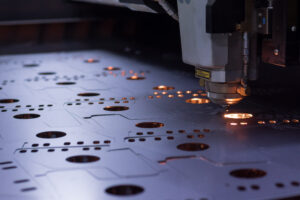Intro
People often reach out to our expert machinists and ask what manufacturing process would be right for their upcoming project. To help everyone out, we started our series of blog posts about different manufacturing options, how they work, and when you should pick them.
Today’s guide is all about sheet metal laser cutting. We’ll cover what laser cutting is, the different types, pros and cons of this technology, and the fundamentals you need to know.
What Is Laser Cutting?
The name is not a joke, laser cutting is a manufacturing process where a laser physically cuts through sheets of metal, wood, plastic, leather, and more. In most machine shops, a laser cutter is strictly used for cutting sheet metal.
If you know how waterjet cutters work, you already understand the fundamentals of laser cutters.
There are a few different types of laser cutters, but they all work with the same principle — a strong laser will cut straight lines through a sheet of metal underneath. The head of the laser moves around, typically on a 2-axis or 3-axis gantry.
The laser is cutting based off a series of G-code, which is a machine language that comes from your CAD model.
A laser cutter can cut internal holes, features, and geometries as well as cutting out outlines of parts. This makes it a versatile addition to any machine shop that works with sheet metal.
Types of Sheet Metal Laser Cutters
There are three main types of laser cutters that you’ll find in an everyday machine shop: fiber lasers, CO2 lasers, and crystal lasers.
Fiber Laser Cutters
In our experience, fiber laser cutters are one of the more popular options. They require very little maintenance to upkeep, and they can easily run for 25,000 hours.
This technology uses long, thin strips of glass fibers to amplify the laser beam. This produces a lot of power, but a larger cutting kerf (which is sometimes good and sometimes bad). A fiber laser cutter can handle metal, alloys, plastics, glass, and wood with ease.
CO2 Laser Cutters
A CO2 laser uses a combination of inert gases and carbon dioxide (CO2, hence the name) to cut through material. It’s a simpler laser cutter, but they require a constant supply of gas to keep them running.
They’re especially good with non-metal materials, but they can handle aluminum and stainless steel sheets without any issues. They require more upkeep, especially in keeping the lens clean so you get a clean cut every time.
Their lifetime is a little shorter than fiber lasers, but much longer than crystal laser cutters.
Crystal Laser Cutters
The final option is the crystal laser cutter, which is also the most high-tech. It uses one of two high-power cutting devices, either Nd:YAH or Me:YVO (you don’t need to understand these acronyms at all). The machine is a lot more expensive than the other two cutters, and it lasts the least amount of time before major repairs are

Since they’re so high-tech, it shouldn’t be a surprise that this laser cutter can handle almost anything you put under it. It can handle thicker aluminum, stainless steel, cast iron, titanium, and plenty of non-metals (including ceramics).
Benefits of Sheet Metal Laser Cutting
Why would you choose laser cutting for your next sheet metal project? There are a few major benefits.
- It’s very fast. A laser cutter can easily make dozens of parts in less than an hour. Once the machine is set up, it can continuously knock out more parts.
- One machine can handle multiple thicknesses. There’s no need to swap out cutting tools or change the bed configuration — a single laser cutter can tackle multiple different material thicknesses. We just need to change the laser power and head height in the settings of the cutting file.
- Avoids CNC machining altogether. Even a well-run shop, like ours at Rapid Axis, runs into an issue where a queue forms for CNC machining. It means you have to wait in line before we can start on your project. With laser cutters, it’s rare to have a queue of projects since each project is done so quickly. We can start on your project sooner and deliver it sooner.
- Allows for more design freedom. Laser cutting heads are very flexible and versatile. As a result, you can take bigger freedoms in your design with confidence.
- Can create multiple pieces at once. If we have a big sheet of metal and we need to make a dozen parts for you, we can set up the operation to cut them all at once. This translates to less startup time, less wasted material, and less room for error — A lower cost for you and faster project deliveries.
Downsides of Sheet Metal Laser Cutting
There are a few downsides to discuss as well.
- Limitations to part thickness. Even though laser cutters can handle a wide range of material thicknesses, there’s an upper limit. This is why we typically only recommend our laser cutter for sheet metal projects.
- Requires a specialist. A general machinist can’t run a laser cutter, it takes a specialist. You need to find a shop that has laser cutting experts on-staff, or else your parts will turn out wrong.
- Not all shops have laser cutters. Most shops in America have a plethora of CNC machinery, but not all of them have laser cutters. You’ll need to do your homework to find a high-quality shop that can help out.
Conclusion
We just finished reviewing the fundamentals of sheet metal laser cutting. This technology can deliver high accuracy and fast turnarounds for your parts, and it’s a great alternative to CNC machining for sheet metal parts and assemblies.
At Rapid Axis, we offer full-service laser cutting. Our laser cutting experts will quickly take care of your project and deliver high-quality parts that you deserve. Get a free quote today to get started.

